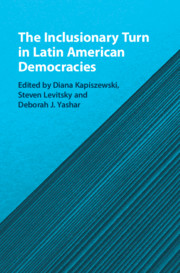Book contents
- The Inclusionary Turn in Latin American Democracies
- The Inclusionary Turn in Latin American Democracies
- Copyright page
- Contents
- Figures
- Tables
- Contributors
- Acknowledgments
- Prologue: Reflections on Two Episodes of Popular Inclusion
- 1 Inequality, Democracy, and the Inclusionary Turn in Latin America
- Part I Extending Social Policy and Participation
- Part II Inclusion and Partisan Representation
- 6 Changing Patterns of Ideology and Partisanship in Latin America
- 7 Brokering Inclusion
- 8 States of Discontent
- Part III New Party–Society Linkages
- Part IV Inclusion, Populism, and Democracy
- References
6 - Changing Patterns of Ideology and Partisanship in Latin America
from Part II - Inclusion and Partisan Representation
Published online by Cambridge University Press: 12 January 2021
- The Inclusionary Turn in Latin American Democracies
- The Inclusionary Turn in Latin American Democracies
- Copyright page
- Contents
- Figures
- Tables
- Contributors
- Acknowledgments
- Prologue: Reflections on Two Episodes of Popular Inclusion
- 1 Inequality, Democracy, and the Inclusionary Turn in Latin America
- Part I Extending Social Policy and Participation
- Part II Inclusion and Partisan Representation
- 6 Changing Patterns of Ideology and Partisanship in Latin America
- 7 Brokering Inclusion
- 8 States of Discontent
- Part III New Party–Society Linkages
- Part IV Inclusion, Populism, and Democracy
- References
Summary
This chapter compares the temporal evolution of the alignment between ideological platforms and the social bases of partisan support in ten Latin American countries (the eight political party systems from Collier and Collier [1991], plus Bolivia and Ecuador). The chapter shows that whereas the correlation between a party’s ideology and its partisan support among marginalized voters (the poor and informal sector workers) was very weak during the neoliberal consensus of the 1990s, in recent years leftist parties have been more successful in attracting this electorate. At the same time, however, leftist parties’ support from its traditional base (the formal working class and public sector employees) weakened during this time period. Moreover, the extent of this realignment was much stronger in some countries (Brazil, Peru and to some extent Argentina and Venezuela) than in others. The final section of the chapter identifies and evaluates alternative explanations for these cross-national trajectory differences and finds that extensive realignment was more likely to occur in countries where leftist incumbents relied at least moderately on patronage in their electoral strategies. This finding questions the durability of the realignment once leftist parties are out of power.
Keywords
- Type
- Chapter
- Information
- The Inclusionary Turn in Latin American Democracies , pp. 185 - 218Publisher: Cambridge University PressPrint publication year: 2021

